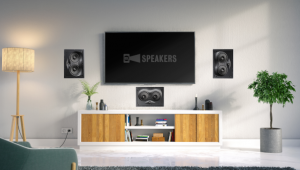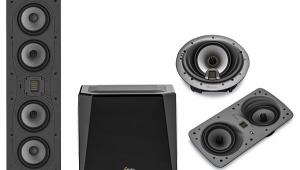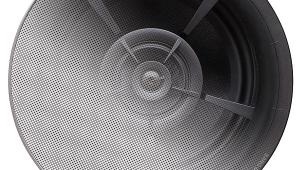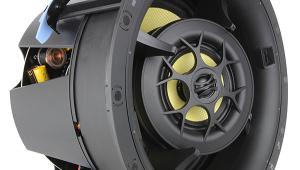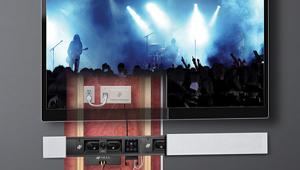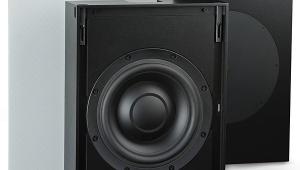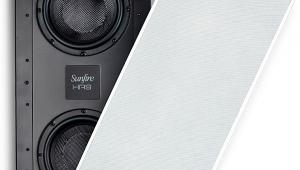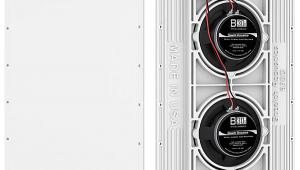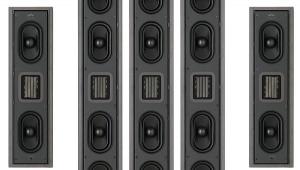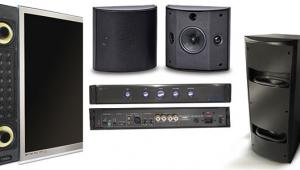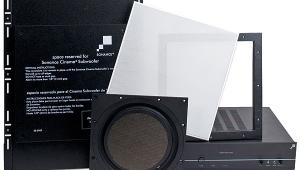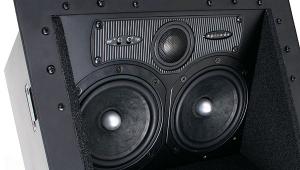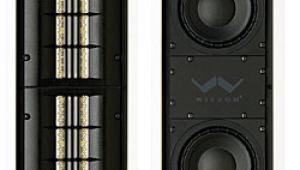SpeakerCraft Starlet 4 In-Wall Loudspeakers
The speakers in my walls are probably more expensive than the paintings many art lovers have on theirs. That's because good sound is important to me. Fine art is wonderful, but I get as much pleasure from accurate loudspeakers as an art lover gets from an exceptional painting or object d'art. So it doesn't bother me that the SpeakerCraft Starlet 4 in-wall speakers cost close to $4,000 per pair. I'll gladly spend more to get the performance I want.
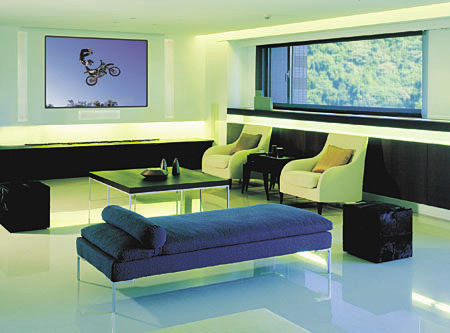
SpeakerCraft is one of the leading suppliers of architectural loudspeakers and custom installation components. They manufacture a broad selection of in-wall and in-ceiling speakers, subwoofers, amplifiers, and control systems, as well as installation accessories.
The Starlet 4 speakers reside at the low end of SpeakerCraft's series of high-end in-wall speakers. They also make the Starlet 6 and Starlet 9 models, which are taller and have more drivers and a longer array of tweeters. The Starlet 4 speakers have four 6.5-inch Kevlar woofers mounted vertically behind four ribbon tweeters, forming a coincident line source. The larger models have six and nine sets of drivers, respectively. Still, the Starlet 4s are big by in-wall standards at 9.25 inches wide by 36.75 inches tall. They are obviously intended for the serious music listener and home theater enthusiast. Who else would cut such large holes in their walls for speakers?
The Starlet 4 speaker is enclosed in a shallow back box, or cabinet, which is responsible for much of its low-frequency acoustic performance. This distinguishes it from a typical in-wall speaker with no back box, which relies on the wall cavity for aspects of its acoustic character. The Starlet 4's bezel is designed in the spirit of a wave guide to ensure smooth dispersion of sound into the room.
Installation
Installing the Starlet 4 takes more preparation and planning than is generally required for a smaller in-wall speaker. The Starlet 4 is a line-source loudspeaker designed to control the propagation of sound into the room. This results in wide horizontal dispersion but rather confined vertical dispersion. Thus, SpeakerCraft recommends a specific installation height for the best sound quality. In order to achieve a concise stereo image and transparent high-frequency output, they advise you to place the vertical center of the Starlet 4 speaker 48 to 49 inches above the floor, or 5 to 7 inches above the listener's ear height while seated. For larger rooms, or when people will be standing while listening, SpeakerCraft recommends the taller Starlet 6 or Starlet 9 models. I have a 15-by-18-foot listening room, and I prefer to sit while I listen, so the Starlet 4 is a good choice for my room.
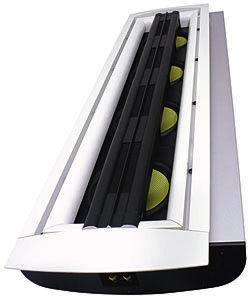 Since the Starlet 4 is larger than most in-walls, it's important to search a larger area behind the wall for obstructions, such as studs, pipes, wires, or other objects. A stud finder is useful for this purpose. You could also drill a small hole in the wall and insert a coat hanger to feel about for obstructions or cut a slightly larger hole and insert a small mirror to look inside the wall. Remember, if you do discover any obstructions that force you to install the loudspeaker elsewhere, a smaller hole is easier to patch than a larger hole.
Since the Starlet 4 is larger than most in-walls, it's important to search a larger area behind the wall for obstructions, such as studs, pipes, wires, or other objects. A stud finder is useful for this purpose. You could also drill a small hole in the wall and insert a coat hanger to feel about for obstructions or cut a slightly larger hole and insert a small mirror to look inside the wall. Remember, if you do discover any obstructions that force you to install the loudspeaker elsewhere, a smaller hole is easier to patch than a larger hole.
The Starlet 4 speaker comes in three pieces. You install the speaker enclosure into the wall cavity behind the wallboard and secure it with a bezel/flange assembly. The bezel attaches to the enclosure with eight screws. The speakers are rather heavy at 33 pounds each, but SpeakerCraft includes a mounting bracket for extra support, which installs at the bottom of the wall cutout. The two-piece bracket (front and back) provides support for the speaker, and it makes installation easier because you can rest the speaker on the bracket while you attach the bezel. Once you've attached and secured the bezel, you can easily install the grille on the front of the bezel. (SpeakerCraft highly recommends that you hire a qualified specialist to install the Starlet Series speakers.)
Design and Build Quality
The SpeakerCraft Starlet 4s are solid, well-built speakers. The entire enclosure, including the ribbon-tweeter array and bezel, is constructed of heavy-gauge aluminum. The four 6.5-inch woofer cones are made of rigid, lightweight Kevlar with front-mounted Neodymium magnets. This minimizes the required space behind the baffle and allows for a shallow back box.
Amplifier and Wiring Requirements
SpeakerCraft recommends an amplifier with a minimum rated power of 75 watts per channel for any of the Starlet Series speakers. (Unlike the Starlet 4, the Starlet 6 and Starlet 9 require two amplifier channels per speaker, however.) An amplifier or receiver with low impedance capability is also advised because the Starlet 4's nominal impedance is rated at 6 ohms.
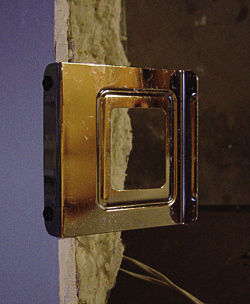 For the best sound quality, SpeakerCraft suggests that you biwire the Starlet 4 with 12-gauge (or larger) wire. Electrically identical binding-post terminals are located at each end of the speaker enclosure, so you can run parallel wires to each end of the speaker.
For the best sound quality, SpeakerCraft suggests that you biwire the Starlet 4 with 12-gauge (or larger) wire. Electrically identical binding-post terminals are located at each end of the speaker enclosure, so you can run parallel wires to each end of the speaker.
Listening Evaluation
The Starlet 4 speakers need a subwoofer because they have no inherent deep-bass capability. According to SpeakerCraft, their response rolls off quickly below 90 hertz. SpeakerCraft offers powered in-wall, in-ceiling, and floorstanding subwoofers, but I used my Yamaha YST-SW100 sub with two 8-inch woofers for this review. The other components in my system consisted of a Sherwood R-965 receiver with 120 watts per channel, a Yamaha DVD-S2300 DVD/SACD player, and MIT speaker cables and interconnects.
I admit that I have a fondness for ribbon tweeters. When implemented skillfully, their delicate, airy, and detailed upper midrange and treble make for effortless, transparent listening. They're not in your face, just there—not harsh or brittle, but smooth and easy to listen to for long periods of time. The ribbon tweeters in the Starlet 4s lived up to my expectations and also excelled with vocals. One of my favorite discs is a new SACD release, Ultimate Mancini (Concord Records), featuring all of Henry Mancini's great scores, many of them performed by his daughter, Monica. As expected, her voice sounded lush and sweet, complemented by a fabulous orchestra. Imaging was precise, and soundstaging was wide, even when I sat off-axis. SpeakerCraft goes so far as to suggest that a center channel might not be necessary for multichannel systems because of the Starlet 4's imaging qualities. I believe it. When I closed my eyes, Monica Mancini was right there in the room during her rendition of "Music on the Way." Awesome! As I mentioned, the Starlet 4's mid- and high-frequency response is very sensitive to vertical placement. They have wide horizontal dispersion but lose high frequencies when placed vertically.
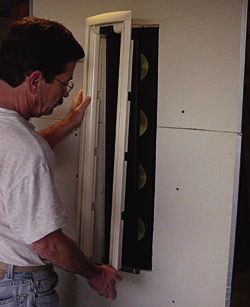 Another of my favorite discs is from Nickel Creek (Sugar Hill Records), an Irish trio with two recent releases on SACD. Their music and vocals range from traditional Irish folk to an eclectic blend of rock and blues. They play a variety of stringed instruments, including the fiddle, the mandolin, and the bouzouki, which is related to the lute. Again, the Starlet 4 in-walls kept me rapt with delight. Even when multiple stringed instruments were playing, it was easy to distinguish one from the others.
Another of my favorite discs is from Nickel Creek (Sugar Hill Records), an Irish trio with two recent releases on SACD. Their music and vocals range from traditional Irish folk to an eclectic blend of rock and blues. They play a variety of stringed instruments, including the fiddle, the mandolin, and the bouzouki, which is related to the lute. Again, the Starlet 4 in-walls kept me rapt with delight. Even when multiple stringed instruments were playing, it was easy to distinguish one from the others.
Bass response is another story. I didn't expect any deep bass from the Starlet 4s. But, after I took the time to adjust my sub's crossover to blend with the Starlet 4s' roll-off point, everything snapped into place.
In Conclusion
For some art lovers, it might seem absurd to spend this much money on speakers. But music is art, and I enjoyed imbibing that art through the SpeakerCraft Starlet 4 speakers for hours. They are well built and relatively easy to install, even if they are heavy. Their line-source design and ribbon tweeters produce great sound (even though it's over a fairly limited vertical arc) and are the reasons I would recommend the Starlet 4s to a serious music enthusiast. If you enjoy sitting in the sweet spot while you listen to music and can install these speakers at the recommended height, they're excellent.
Highlights
• The drivers are arranged in a coincident line-source design
• The extruded-aluminum bezels are well built and attractive
• This speaker delivers precise imaging and a wide soundstage
